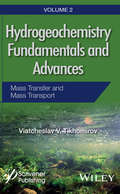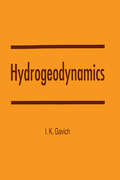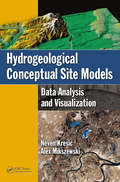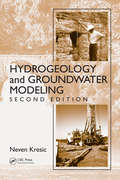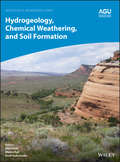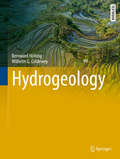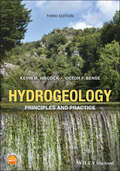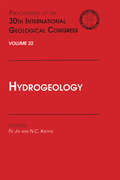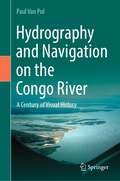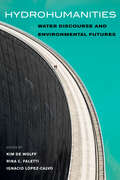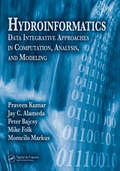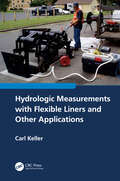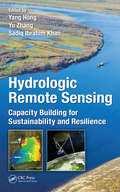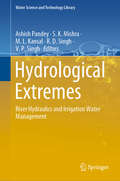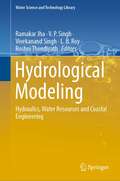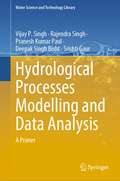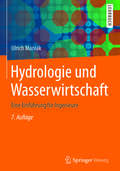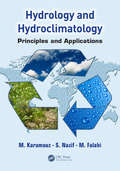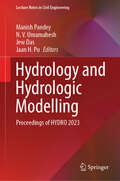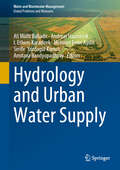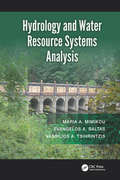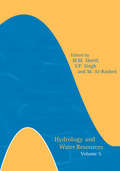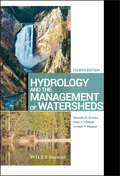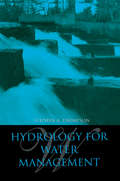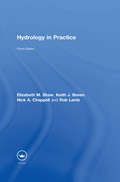- Table View
- List View
Hydrogeochemistry Fundamentals and Advances: Mass Transfer and Mass Transport
by Viatcheslav V. TikhomirovWater is the Earth’s most precious resource. Until recent years, water was often overlooked as being overly abundant or available, but much has changed all over the world. As climate change, human encroachment on environmental areas, and deforestation become greater dangers, the study of groundwater has become more important than ever and is growing as one of the most important areas of science for the future of life on Earth. This three-volume set is the most comprehensive and up-to-date treatment of hydrogeochemistry that is available. The first volume lays the foundation of the composition, chemistry, and testing of groundwater, while volume two covers practical applications such as mass transfer and transport. Volume three, which completes the set, is an advanced study of the environmental analysis of groundwater and its implications for the future. This second volume focuses more deeply on hydrogeochemical processes, such as mass transfer and mass transport, element migration, and many others that are important for a more thorough and advanced understanding of the subject. Whether as a textbook or a reference work, this volume is a must-have for any library on hydrogeochemistry.
Hydrogeodynamics
by I.K. GavichThis text focuses particularly on the growing interest in hydrodynamic principles of the study of underground waters, new methods of eco-based hydrogeodynamic analysis, and the estimation of the quantity of infiltration water transfer. The author also discusses aspects of mass transfer by subsurface water flow in the light of molecular kinetics, and examines a new apporach to investigating the slow movements of groundwater at the deep zones of the hydrolithosphere.
Hydrogeological Conceptual Site Models: Data Analysis and Visualization
by Neven Kresic Alex MikszewskiA reference for students, researchers, and environmental professionals, Hydrogeological Conceptual Site Models: Data Analysis and Visualization explains how to develop effective conceptual site models, perform advanced spatial data analysis, and generate informative graphics for applications in hydrogeology and groundwater remediation. Written by e
Hydrogeology and Groundwater Modeling
by Neven KresicCoupling the basics of hygrogeology with analytical and numerical modeling methods, Hydrogeology and Groundwater Modeling, Second Edition provides detailed coverage of both theory and practice. Written by a leading hydrogeologist who has consulted for industry and environmental agencies and taught at major universities around the world, this unique
Hydrogeology, Chemical Weathering, and Soil Formation (Geophysical Monograph Series #258)
by Allen Hunt Markus EgliExplores soil as a nexus for water, chemicals, and biologically coupled nutrient cycling Soil is a narrow but critically important zone on Earth’s surface. It is the interface for water and carbon recycling from above and part of the cycling of sediment and rock from below. Hydrogeology, Chemical Weathering, and Soil Formation places chemical weathering and soil formation in its geological, climatological, biological and hydrological perspective. Volume highlights include: The evolution of soils over 3.25 billion years Basic processes contributing to soil formation How chemical weathering and soil formation relate to water and energy fluxes The role of pedogenesis in geomorphology Relationships between climate soils and biota Soils, aeolian deposits, and crusts as geologic dating tools Impacts of land-use change on soils The American Geophysical Union promotes discovery in Earth and space science for the benefit of humanity. Its publications disseminate scientific knowledge and provide resources for researchers, students, and professionals.
Hydrogeology: Introduction To Applied Hydrogeology (Springer Textbooks in Earth Sciences, Geography and Environment)
by Bernward Hölting Wilhelm G. ColdeweyThis textbook provides a complete introduction to Hydrogeology. It is a comprehensive reference for earth science professionals involved in groundwater exploitation as well as for geotechnical engineers. This English translation of the German textbook "Hydrogeologie" by Hölting & Coldewey, which has been published in its 8th edition, provides insights into the sources and reservoirs of groundwater, the dynamics of fluid flow, and the physical and chemical composition of groundwater. It also gives an overview about the economic value of groundwater and its exploitation and use. A consistent use of the internationally accepted SI units as well as the formula symbols in the text contributes to the understandability.
Hydrogeology: Principles and Practice
by Kevin M. Hiscock Victor F. BenseHYDROGEOLOGY Hydrogeology: Principles and Practice provides a comprehensive introduction to the study of hydrogeology to enable the reader to appreciate the significance of groundwater in meeting current and future environmental and sustainable water resource challenges. This new edition has been thoroughly updated to reflect advances in the field since 2014 and includes over 350 new references. The book presents a systematic approach to understanding groundwater starting with new insights into the distribution of groundwater in the Earth’s upper continental crust and the role of groundwater as an agent of global material and elemental fluxes. Following chapters explain the fundamental physical and chemical principles of hydrogeology, and later chapters feature groundwater field investigation techniques in the context of catchment processes, as well as chapters on groundwater quality and contaminant hydrogeology, including a section on emerging contamination from microplastic pollution. Unique features of the book are chapters on the application of environmental isotopes and noble gases in the interpretation of aquifer evolution, and a discussion of regional characteristics such as topography, compaction and variable fluid density on geological processes affecting past, present and future groundwater flow regimes. The last chapter discusses future challenges for groundwater governance and management for the long-term sustainability of groundwater resources, including the role of managed aquifer recharge, and examines the linkages between groundwater and climate change, including impacts on cold-region hydrogeology. Given the drive to net-zero carbon emissions by 2050, the interaction of groundwater in the exploitation of energy resources, including renewable resources and shale gas, is reviewed. Throughout the text, boxes and a set of colour plates drawn from the authors’ teaching and research experience are used to explain special topics and to illustrate international case studies ranging from transboundary aquifers and submarine groundwater discharge to the hydrogeochemical factors that have influenced the history of malting and brewing in Europe. The appendices provide conversion tables and useful reference material, and include review questions and exercises, with answers, to help develop the reader’s knowledge and problem-solving skills in hydrogeology. This highly informative and accessible textbook is essential reading for undergraduate and graduate students primarily in earth sciences, environmental sciences and physical geography with an interest in hydrogeology or groundwater topics. The book will also find use among practitioners in hydrogeology, soil science, civil engineering and landscape planning who are involved in environmental and resource protection issues requiring an understanding of groundwater.
Hydrogeology: Proceedings of the 30th International Geological Congress, Volume 22
by Fei JinThis book is a collection of papers presented in the symposia, held in Beijing, on hydrogeology. The papers deal with different topics providing information on some problems on riverside groundwater, assessment of groundwater contamination, and groundwater protection strategy.
Hydrography and Navigation on the Congo River: A Century of Visual History
by Paul Van PulIn a time without GPS and echosounder, European engineers and black labourers worked for decades to get a better understanding of the nautical intricacies of the Congo River. This is the first comprehensive story, in text and custom-made maps, of the, in flow, second largest river in the world. We follow the earliest explorers mapping the river, the expeditions to find an alternative access to the ocean and the first land and hydraulic surveys to improve navigation. The constant movement of shallows and islands keeps the guardians of the river constantly on their toes. Over the years, better technologies on all fronts improved safety, data collection and fairway maintenance. In conclusion, the author describes a proposal to develop a 21st container port that would rival any port facilities on the African west coast.
Hydrohumanities: Water Discourse and Environmental Futures
by Kim De Wolff, Rina C. Faletti and Ignacio López-CalvoA free open access ebook is available upon publication. Learn more at www.luminosoa.org. Discourse about water and power in the modern era have largely focused on human power over water: who gets to own and control a limited resource that has incredible economic potential. As a result, discussion of water, even in the humanities, has traditionally focused on fresh water for human use. Today, climate extremes from drought to flooding are forcing humanities scholars to reimagine water discourse. This volume exemplifies how interdisciplinary cultural approaches can transform water conversations. The manuscript is organized into three emergent themes in water studies: agency of water, fluid identities, and cultural currencies. The first section deals with the properties of water and the ways in which water challenges human plans for control. The second section explores how water (or lack of it) shapes human collective and individual identities. The third engages notions of value and circulation to think about how water has been managed and employed for local, national, and international gains. Contributions come from preeminent as well as emerging voices across humanities fields including history, art history, philosophy, and science and technology studies. Part of a bigger goal for shaping the environmental humanities, the book broadens the concept of water to include not just water in oceans and rivers but also in pipes, ice floes, marshes, bottles, dams, and more. Each piece shows how humanities scholarship has world-changing potential to achieve more just water futures.
Hydroinformatics: Data Integrative Approaches in Computation, Analysis, and Modeling
by Praveen Kumar Mike Folk Momcilo Markus Jay C. AlamedaModern hydrology is more interdisciplinary than ever. Staggering amounts and varieties of information pour in from GIS and remote sensing systems every day, and this information must be collected, interpreted, and shared efficiently. Hydroinformatics: Data Integrative Approaches in Computation, Analysis, and Modeling introduces the tools, approache
Hydrologic Measurements with Flexible Liners and Other Applications
by Carl KellerThis book provides hydrologists the information needed for the characterization of contaminated subsurface hydrologic sites. It explains how to seal boreholes, map contaminant distribution in a formation, map the flow zones, and measure the hydraulic head distribution through a single flexible liner. Results of the measurement methods provided demonstrate the reality and reliability of the unique FLUTe techniques. These measurements help to predict contaminant migration and aid in the design of a groundwater remedy. The limitations of several methods are provided to allow an intelligent choice of methods and a well-informed selection of devices among the alternative methods. The mechanics of flexible liner systems are explained with examples of applications beyond the hydrologic measurements such as relining of piping. Features include: The first book on a modern technology that is replacing traditional technology globally Written by the inventor of the FLUTe technology with 25 years’ experience with successful applications Describes FLUTe technology in detail, including the theory behind the tools, how to use the tools, and the mathematics used to interpret the data generated by the tools Provides step-by-step explanations of how to conduct fieldwork and how to analyze the data gathered Minimizes reliance on mathematical explanations and uses illustrations and examples that allow readers to understand the technology This book is of interest to environmental professionals, mine operators, petroleum engineers, geophysicists who use these methods or are considering using these methods for remediation of groundwater contamination, academics, students, and regulators.
Hydrologic Remote Sensing: Capacity Building for Sustainability and Resilience
by Yu Zhang Yang Hong Sadiq Ibrahim KhanEnvironmental remote sensing plays a critical role in observing key hydrological components such as precipitation, soil moisture, evapotranspiration and total water storage on a global scale. As water security is one of the most critical issues in the world, satellite remote sensing techniques are of particular importance for emerging regions which have inadequate in-situ gauge observations. This book reviews multiple remote sensing observations, the application of remote sensing in hydrological modeling, data assimilation and hydrological capacity building in emerging regions.
Hydrological Extremes: River Hydraulics and Irrigation Water Management (Water Science and Technology Library #97)
by V. P. Singh Ashish Pandey S. K. Mishra M. L. Kansal R. D. SinghThis book presents quality technical papers representing the recent developments in the field of hydrological modeling, water management and water governance including practical applications. The content covers multifarious aspects of hydrology and water resources. It includes an application of the Hydrologic Modelling System (HEC-HMS) which has been successfully demonstrated for assessment of floods. The authors suggest an approach for the mitigation of cyclone disaster through a case study of the Phailin cyclone, whilst considering mitigating pluvial flooding, developing suitable management strategies. The book includes chapters discussing the detrended fluctuation analysis which is carried out for multifractal description of droughts. Drought characteristics are analyzed, and drought indices evolved for drought preparedness/management. The use of science in community planning under changing climate is also studied and discussed. The authors present and experimental study wherein hydraulic coefficients are calibrated by using vertical orifice. A cross flow hybrid hydrokinetic turbine is also evaluated for performance, and high head regulating radial gate designed and studied its sensitivity.This book will appeal to researchers, field practitioners, NGO and other Governmental as well as private water practitioners
Hydrological Modeling: Hydraulics, Water Resources and Coastal Engineering (Water Science and Technology Library #109)
by V. P. Singh Ramakar Jha Vivekanand Singh L. B. Roy Roshni ThendiyathThis book carefully considers hydrological models which are essential for predicting floods, droughts, soil moisture estimation, land use change detection, geomorphology and water structures. The book highlights recent advances in the area of hydrological modelling in the Ganga Basin and other internationally important river basins. The impact of climate change on water resources is a global concern. Water resources in many countries are already stressed, and climate change along with burgeoning population, rising standard of living and increasing demand are adding to the stress. Furthermore, river basins are becoming less resilient to climatic vagaries. Fundamental to addressing these issues is hydrological modelling which is covered in this book. Integrated water resources management is vital to ensure water and food security. Integral to the management is groundwater and solute transport, and this book encompasses tools that will be useful to mitigate the adverse consequences of natural disasters.
Hydrological Processes Modelling and Data Analysis: A Primer (Water Science and Technology Library #127)
by Rajendra Singh Vijay P. Singh Deepak Singh Bisht Pranesh Kumar Paul Srishti GaurThis book provides a state-of-the-art overview of the concepts and methodologies of data and modelling-driven hydrological analyses and their wide range of practical applications. The book is driven by the realisation that science, technology, engineering, and mathematics (STEM) concepts are essential in engineering hydrology to produce well-trained hydrologists. Such hydrologists will be equipped to face future societal challenges that require enhanced information and communication technology tools and integration of technical and non-technical areas. The book contains 12 chapters that introduce the principles of hydrological data analysis and highlight the current and emerging tools and techniques for analysing hydrologic data. The book describes the types of data typically used in hydrological analyses. It highlights the revolutionary technological advancements made toward hydrological data collection, including the use of drones and smartphones. The foremost objective of the book is to present the hydrological data analysis procedures. It explains the steps involved in data analysis for easy understanding of the reader, including students and professionals. This book presents case studies that demonstrate step-by-step procedures involved in typical analysis problems and may guide students and professionals in planning and executing steps to analyse the problem at hand. Case study examples will guide them to understand the intricacies of hydrological data analysis. It provides the readers with a complete package to enrich their understanding of the hydrological data analysis tools and techniques. Subsequently, as well-trained hydrologists, they could execute their learning to meet any specific grand challenge of the twenty-first century.
Hydrologie und Wasserwirtschaft: Eine Einführung für Ingenieure (Springer-Lehrbuch)
by Ulrich ManiakDie aktualisierte und #65533;berarbeitete 7. Auflage des FachbuchsHydrologie und Wasserwirtschaft beschreibt hydrologische Grundlagen undL#65533;sungsans#65533;tze f#65533;r Aufgaben in der Wassermengen- und -g#65533;tewirtschaft und imGew#65533;sserschutz. Erweitert wurden die Verfahren der Abflussermittlung undDatenverarbeitung sowie die Ermittlung von Bemessungswerten f#65533;r Wasserbautenund ihren Betrieb mit Flussgebietsmodellen, auch unter Einfluss desKlimawandels, der Risikobetrachtungen f#65533;r ihr Versagen und derDurchflussvorhersage. Erg#65533;nzt wurden Stoffbilanz- und -transportmodelle zurPrognose der Gew#65533;sserg#65533;te bei Sanierungsma#65533;nahmen. Die Interpretation derErgebnisse wird durch zahlreiche Praxisbeispiele veranschaulicht. Die Neuauflageist ein unverzichtbares Arbeitsbuch, genau und aktuell auf die Praxis desIngenieurs zugeschnitten.
Hydrology and Hydroclimatology: Principles and Applications
by M. Karamouz S. Nazif M. FalahiThis book presents a systematic approach to understanding and applying the principles of hydrology and hydroclimatology, examining the interactions among different components of the water cycle. It takes a fresh look at the fundamentals and challenges in hydrologic and hydroclimatic systems as well as climate change. The author describes the applic
Hydrology and Hydrologic Modelling: Proceedings of HYDRO 2023 (Lecture Notes in Civil Engineering #410)
by Manish Pandey Jaan H. Pu N. V. Umamahesh Jew DasThis book comprises proceedings of the 28th International Conference on Hydraulics, Water Resources, River and Coastal Engineering (HYDRO 2023). It focuses on emerging opportunities and challenges in the field of hydrology and hydrological modelling. The book covers a range of topics including, but not limited to, groundwater modelling and management, integrated water resources and watershed management, surface water hydrology, drought assessment and mitigation, risk, reliability and design of hydrologic systems. The book presents these topics in the form of illustrations and tables, thereby providing the readers with an in-depth insight into the recent research. It also addresses fundamental concepts and studies in the field of hydrology and hydrological modelling, making it a valuable resource for researchers and professionals working in the fields of hydraulics, water resources and coastal engineering.
Hydrology and Urban Water Supply (Water and Wastewater Management)
by Amitava Bandyopadhyay Andreas Haarstrick Ali Müfit Bahadir I. Ethem Karadirek Mehmet Emin Aydin Serife Yurdagül KumcuThis book explores the intricate relationship between hydrology and urban water provision. Authored by experts in the field, this book offers a comprehensive exploration of the challenges and solutions associated with urban water supply management in the context of hydrology. It covers topics such as water sources, treatment technologies, distribution systems, and sustainable water management practices. With its meticulous analysis and practical insights, this book equips professionals, researchers, and policymakers with the knowledge necessary to address the growing demands of urban water supply in an era of climate change and urbanization.
Hydrology and Water Resource Systems Analysis
by Maria A. Mimikou Evangelos A. Baltas Vassilios A. TsihrintzisHydrology and water resources analysis can be looked at together, but this is the only book which presents the relevant material and which bridges the gap between scientific processes and applications in one text. New methods and programs for solving hydrological problems are outlined in a concise and readily accessible form. Hydrology and Water Resource Systems Analysis includes a number of illustrations and tables, with fully solved example problems integrated within the text. It describes a systematic treatment of various surface water estimation techniques; and provides detailed treatment of theory and applications of groundwater flow for both steady-state and unsteady-state conditions; time series analysis and hydrological simulation; floodplain management; reservoir and stream flow routing; sedimentation and erosion hydraulics; urban hydrology; the hydrological design of basic hydraulic structures; storage spillways and energy dissipation for flood control, optimization techniques for water management projects; and methods for uncertainty analysis. It is written for advanced undergraduate and graduate students and for practitioners. Hydrologists and water-related professionals will be helped with an unfamiliar term or a new subject area, or be given a formula, the procedure for solving a problem, or guidance on the computer packages which are available, or shown how to obtain values from a table of data. For them it is a compendium of hydrological practice rather than science, but sufficient scientific background is provided to enable them to understand the hydrological processes in a given problem, and to appreciate the limitations of the methods presented for solving it.
Hydrology and Water Resources: Volume 5- Additional Volume International Conference on Water Resources Management in Arid Regions, 23-27 March 2002, Kuwait
by Boca RatonThis is the fifth and last volume representing the proceedings of the International Conference on Water Resources Management in Arid Regions held March 23rd-27th 2002 in Kuwait. This book discusses major aspects of hydrology and water resources. It presents papers on important aspects of surface water and groundwater hydrology, including drought tendencies, regional flood frequency analysis, urban storm drainage with curb-opening inlets, isotopic investigations for lakes, hydrologic and sediment transport modeling, groundwater exploration using remote sensing and GIS, origin and recharge rates of alluvial ground waters, stormwater and groundwater management, and considerations for stochastic finite element in geostatistics and modeling. Papers on water quality supplement the discussion.
Hydrology and the Management of Watersheds
by Peter F. Ffolliott Kenneth N. Brooks Joseph A. MagnerThis new edition is a major revision of the popular introductory reference on hydrology and watershed management principles, methods, and applications. The book's content and scope have been improved and condensed, with updated chapters on the management of forest, woodland, rangeland, agricultural urban, and mixed land use watersheds. Case studies and examples throughout the book show practical ways to use web sites and the Internet to acquire data, update methods and models, and apply the latest technologies to issues of land and water use and climate variability and change.
Hydrology for Water Management
by Stephen A. ThompsonContaining over one hundred and sixty line drawings, maps and one hundred tables, this book explains the fundamental hydrologic principles and favoured methods of analysis. Aimed at students interested in natural resources and environmental science, spreadsheet exercises and worked examples help to develop basic problem solving skills.
Hydrology in Practice
by Elizabeth M. Shaw Keith J. Beven Nick A. Chappell Rob LambHydrology in Practice is an excellent and very successful introductory text for engineering hydrology students who go on to be practitioners in consultancies, the Environment Agency, and elsewhere. This fourth edition of Hydrology in Practice, while retaining all that is excellent about its predecessor, by Elizabeth M. Shaw, replaces the material on the Flood Studies Report with an equivalent section on the methods of the Flood Estimation Handbook and its revisions. Other completely revised sections on instrumentation and modelling reflect the many changes that have occurred over recent years. The updated text has taken advantage of the extensive practical experience of the staff of JBA Consulting who use the methods described on a day-to-day basis. Topical case studies further enhance the text and the way in which students at undergraduate and MSc level can relate to it. The fourth edition will also have a wider appeal outside the UK by including new material on hydrological processes, which also relate to courses in geography and environmental science departments. In this respect the book draws on the expertise of Keith J. Beven and Nick A. Chappell, who have extensive experience of field hydrological studies in a variety of different environments, and have taught undergraduate hydrology courses for many years. Second- and final-year undergraduate (and MSc) students of hydrology in engineering, environmental science, and geography departments across the globe, as well as professionals in environmental protection agencies and consultancies, will find this book invaluable. It is likely to be the course text for every undergraduate/MSc hydrology course in the UK and in many cases overseas too.
